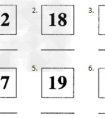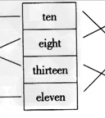用所给词的正确形式填空。1. There are four ______ (season) in a year.2. Are there many pupils in the park on ______ (children) Day?3. Mary and Tom watch TV _-六年级英语
5. 以 -o 结尾的名词变复数时,多数直接加 -s。
例如:radio → radios, piano → pianos, kangaroo → kangaroos;有的须加 -es,中学课本中有几个这样的单词,可以通过一句口诀来记忆:黑人英雄爱吃西红柿和土豆。
即:Negro → Negroes, hero → heroes, tomato → tomatoes, potato → potatoes;有的以 o 结尾的名词既可加 -s 也可加 -es。
例如:volcano (火山) → volcanos / volcanoes 等。
6. 名词复数的不规则变化需要特别记忆。
例如:man → men, woman → women, goose → geese, foot → feet, tooth → teeth, mouse → mice, louse (虱子) → lice, child → children, fish → fish, deer (鹿) → deer, sheep → sheep 等。
7. 初中课本中表示“某国人”的名词复数形式变化可通过歌诀记忆:中日不变英法变,其余 -s 加后面。
例如:Chinese → Chinese, Japanese → Japanese;
Englishman → Englishmen, Englishwoman → Englishwomen, Frenchman → Frenchmen, Frenchwoman → Frenchwomen;
American → Americans, Rusian → Rusians, Arab → Arabs, German → Germans 等。
8. 不可数名词一般只有单数形式,没有复数形式。有些不可数名词可借助单位词表示一定的数量。
例如:a cup of tea 一杯茶
, two piece of paper 两张纸, an item of news 一则新闻
考点名称:名词所有格
- 名词所有格:
表示有生命的东西的名词及某些表示时间、距离、星球、世界、国家等无生命的东西的名词后加’s来表示所有关系,叫做名词所有格。
例如:men’sroom男厕所
ChairmanMao’sworks毛主席著作
amile’sdistance一英里的距离
astone’sthrow一步之遥
themoon’slight月光
但如果该名词是以-s或-es接尾,则只在该名词后加“’”来构成所有格。
例如:3hours’walk三小时的路程
fiveminutes’walk五分钟路程
twomiles’distance两英里的距离 名词所有格用法:
一、’s所有格用法:
1)以s结尾的复数名词直接加“ ' ” 其余加“ 's ”
2)以s结尾的人名加“ ' ”或加“ 's ”
例如:Have you read Robert Browning’s poems?你读过罗伯特-勃郎宁的诗吗?二、of 所有格用法:
凡不能加’s的名词,都可以与of构成短语,来表示所有关系。无生命名词的所有格也可以这么用。
例如:Does anyone know the title of the novel?有谁知道这部小说的名字?
There is a tall maple tree at the end of the road.在这条路的尽头有一棵高高的枫树。
但有特殊情况:
This is a photo of my parents.
如果名词后面有一个较长定语,尽管名词表示有生命的东西,也可以用这种所有格形式。
例如:Did you listen to the speech of the President Clinton over the radio?你听了克林顿总统的广播讲话了吗?
They have the support of the people of the developing countries.他们得到发展中国家人民的支持。三、双重所有格:
所谓“双重所有格(double genitive)”,是指名词所有格或名词性物主代词同of构成的所有格,即“of+名词所有格”。
双重所有格有以下几个特征:
1)“of+名词所有格”中的名词必须表示人,不能表示事物。因此,我们可以说:
a play of Shakespeare’s(莎士比亚的一个戏剧), a friend of my wife’s(我妻子的一个朋友),但却不能说a funnel of the ship’s或 a leg of a table’s,
而且该名词必须是特指的,不能是泛指的。
我们可以说:a friend of the doctor’s(这位医生的一个朋友),a novel of the writer’s(那位作者的一部小说),而不能说a friend of a doctor’s或 a novel of a writer’s。
2)除了修饰的原因外,用双重所有格主要是由于被修饰词有排他性的限定词。
如冠词、某些不定代词、指示代词、疑问代词、数词等。
比如我们不能说 an our old acquaintance,而必须说an old acquaintance of ours(我们的一个老相识);
不能说many their books,正确的说法是 many books of theirs(他们的许多书)。
3)注意区别下列四种表达方式含义的差别:
one of my brother’s friends(明确表示我兄弟有一个以上的朋友)
a friend of my brother’s(暗示我兄弟有一个以上的朋友)
a friend of my brother(对我兄弟有好感的人)
my brother’s friend(我兄弟唯一的一个朋友或刚谈及的那一个朋友)四、特殊所有格:
若一样东西为两人共有,则后一个人名用所有格;如果不是两人共有,而是各有各的,则两个名词都用所有格,且其后名词应为复数。例如:
The woman dressed in blue is Mary and Alice’s mother.
那个穿蓝衣服的妇女是玛丽和爱丽丝的母亲。
You should find what the difference between Mr. Smith’s and Mr.Black’s cars is.
你应当发现史密斯先生与布莱克先生的汽车的不同之处。
考点名称:动名词
- 动名词:
如果一个动词加上了-ing变成了名词,那么这个词称动名词。 动名词是一种兼有动词和名词特征
的非限定动词。它可以支配宾语,也能被副词修饰。动名词有时态和语态的变化。
例:Reading is an art. 读书是一种艺术。
Swimming is a good sport in summer. 游泳是夏天一项好的运动。
There is no saying when he'll come. 很难说他何时回来。
No smoking. (=No smoking is allowed here) . 禁止吸烟!
No parking. 禁止停车!
Let’s go shopping. 让我们去购物。 动名词常见题型:
1)动名词做主语时,谓语动词为单数
2)在动名词和不定式中,作为介词的宾语是动名词
3)动名词的否定直接在其前加否定词,通过代词的宾格或所有格形式给出逻辑主语
例:
I would appreciate_______ back this afternoon.
A.you to call
B.you call
C.you calling
D.you’re calling
(Key:C;换成your calling也对)
4)有些词后只能接动名词
acknowledge;admit; advise;advocate;allow;appreciate; avoid; celebrate; consider; contemplate; defer; delay; deny; detest; discontinue; dislike; dispute; enjoy; it entails; escape; excuse; explain; fancy; feel like; finish; forgive; can’t help; hinder; imagine; it involves; keep; it means; mention; mind; miss; it necessitates; pardon; postpone; practice; prevent; recall; report; resent; resist; risk; suggest; understand...
5)另外还有一些接-ing形式的常用说法
it’s no good; it’s no/little/hardly any/ use; it’s not/hardly/scarcely use; it’s worthwhile; spend money/time; there’s no; there’s no point in; there’s nothing worse than; what’s the use/point...
6)有些词后面加不定式和动名词均可
remember,forget,try,stop,go on,continue,stop,regret,cease,mean后面均可用不定式和-ing形式,但意义截然不容。
例:
remember to do/doing:
①I remembered to post the letters.(指未来/过去未来将要做的动作)
②I remembered posting/having posted the letters.(我记得做过这个动作)
forget与remember的用法类似。
regret的用法:
①I regret to inform you that…(我很遗憾地通知你……)
②I regretted having left the firm after twenty years.(为了“二十年前的离开”而遗憾。)
try to(努力)与try +–ing(试验):
①You really must try to overcome your shyness.
②Try practicing five hours a day.动名词用法口诀:
动名词常泛指,句法作用宾/表/定与主,时态/语态之形式,一般/完成/被动式。
Being done 系被动,不含任何进行意。
用作主语请留意,常用it作形式主语,不指未来发生事,表达的信息系已知。
用作表语请记清,作用相当一名词,检验方法很简单,主与表换位能成立。
用作定语也易辩,表示名词之用途。
用作宾语稍复杂,关键留意谓语动词(跟动名词作宾语的常用动词附后),时态同谓动作比较,先于谓动用完成式,其逻辑主语不固定,在句中/句外均有之。
否定式其前加not,复合式其前加物主词,非句首宾格词也可用,尤其口语中更如此。
说明:
1、主-----主语
2、宾-----宾语
3、表------表语
4、定------定语
5、谓动---谓语动词
- 最新内容
- 相关内容
- 网友推荐
- 图文推荐
| [家长教育] 孩子为什么会和父母感情疏离? (2019-07-14) |
| [教师分享] 给远方姐姐的一封信 (2018-11-07) |
| [教师分享] 伸缩门 (2018-11-07) |
| [教师分享] 回家乡 (2018-11-07) |
| [教师分享] 是风味也是人间 (2018-11-07) |
| [教师分享] 一句格言的启示 (2018-11-07) |
| [教师分享] 无规矩不成方圆 (2018-11-07) |
| [教师分享] 第十届全国教育名家论坛有感(二) (2018-11-07) |
| [教师分享] 贪玩的小狗 (2018-11-07) |
| [教师分享] 未命名文章 (2018-11-07) |


![Hello! You can see ___________crayons. [ ]A. threeB. fourC. five-三年级英语](http://www.00-edu.com/d/file/ks/4/1/15/2019-08-13/small07da1502b58cf7152f184ff6e541c84b1565709386.jpg)



